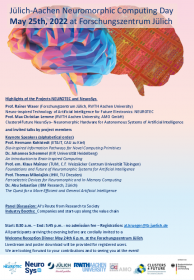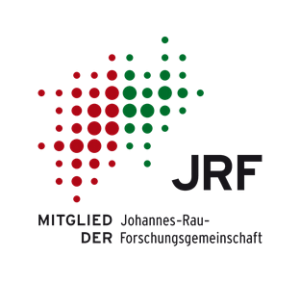Learning From the Brain to Save Energy
AMO GmbH is cooperating with Forschungszentrum Jülich and RWTH Aachen University scientists, as well as with several companies from the region in two major BMBF-funded project, NEUROTEC and NeuroSys, which have the goal of establishing a technological base for neuro-inspired AI hardware made in Europe. Now, having met at the Jülich-Aachen Neuromorphic Computing Day held at Forschungszentrum Jülich on May 24, 2022, Prof. Reiner Waser and Prof. Max Lemme are sharing an insight into the progress of the projects.
 NEUROTEC (Neuro-inspired Technology of Artificial Intelligence for Future Electronics) entered its second phase at the end of 2021 and will receive total funding of around 36 million euros over a five-year period from the German Federal Ministry of Education and Research (BMBF). The cluster NeuroSys (Neuromorphic Hardware for Autonomous Artificial Intelligence Systems) won last year’s Clusters4Future ideas competition and will receive up to 45 million euros in funding from the BMBF. Both projects share the vision of developing the technology needed for building energy-efficient hardware inspired by the human brain and of making the Aachen-Jülich area a leading international location for neuromorphic AI hardware.
NEUROTEC (Neuro-inspired Technology of Artificial Intelligence for Future Electronics) entered its second phase at the end of 2021 and will receive total funding of around 36 million euros over a five-year period from the German Federal Ministry of Education and Research (BMBF). The cluster NeuroSys (Neuromorphic Hardware for Autonomous Artificial Intelligence Systems) won last year’s Clusters4Future ideas competition and will receive up to 45 million euros in funding from the BMBF. Both projects share the vision of developing the technology needed for building energy-efficient hardware inspired by the human brain and of making the Aachen-Jülich area a leading international location for neuromorphic AI hardware.
Prof. Rainer Waser, why exactly do we need neuromorphic computer chips modeled on the human brain?
Prof. Rainer Waser: In NEUROTEC, we focus on an area with a promising future, that of hardware for artificial intelligence applications. However, this area has a very fundamental problem, the energy problem. At the moment, the use of AI is still very energy intensive. Training the models is usually done on supercomputers and requires more and more processing time. Every 3 to 4 months the computing effort doubles, or at least this has been the trend in recent years. With our research we are addressing this problem.
Neuromorphic systems with artificial synapses, in contrast to conventional digital computers, promise to solve these tasks much more efficiently – by several orders of magnitude. In the long term, a wide range of applications is feasible: from the smallest nanosensors, the “smart dust”, through intelligent implants with energy-autonomous AI control, pattern recognition chips in mobile devices, Industry 4.0 controllers that can be trained online, vehicle-based AI electronics for autonomous driving, to mainframe computers that in turn emulate the brain or centrally solve complex AI tasks for the surrounding economy.
The NEUROTEC project is being funded by the Immediate Action Program for Structural Change. It wants to help create new jobs in the Rhenish mining region even before the end of lignite mining. What exactly do you have in mind?
Prof. Rainer Waser: We plan to support the local industry especially in the area of basic technologies. The professional sectors we are addressing here extend far beyond actual chip production. This also includes, for example, plant engineering, measurement technology and electronics development. The second phase of NEUROTEC has got off to a very good start since November 2021 and almost all work packages are on schedule. Some work packages are even slightly ahead of their time.
At the moment, the technology is still in the research and development phase. Nevertheless, we are already seeing the first tangible successes. At this stage, of course, it is primarily jobs for specialized staff that are being created. Later, when the technology is more mature, the focus will shift to industrial production, and the technology will be used on a broad scale. A current example: At the Jülich-Aachen Neuromorphic Computing Day, Prof. Heuken from AIXTRON SE demonstrated the opportunities that will open up in the next few years in terms of new jobs at AIXTRON associated with the new 2D materials. NEUROTEC is investigating whether these materials are suitable for neuromorphic computing.
What are the advantages of this neuromorphic hardware you are developing?
Prof. Rainer Waser: Conventional computer chips are based on transistors. We would like to enhance these transistors with a novel memristive device. Such a “resistor with memory” resembles the synapses in natural neurons and is therefore particularly suitable for artificial neuronal networks, as used in artificial intelligence applications.
An important feature of neuromorphic chips is that computing processes and information storage are no longer physically separated. On conventional computers with so-called Von Neumann architecture, the data transfer between processor and memory, which takes place constantly, is extremely energy-intensive and slows down the computations. What we envision, in contrast, are neuromorphic chips with artificial synapses that can do both: Store information and process it at the same time. Computing is then performed directly in memory – non-volatile – which is also known as computing-in-memory. And it makes it possible to process information in a highly parallel manner. The model here is actually the human brain, which requires an average of just 20 watts – by far less energy than required by a supercomputer that uses AI to perform similar functions.
Prof. Max Lemme, in the NeuroSys cluster you are complementarily driving forward developments in the field of neuromorphic hardware. The topic is also being intensively pursued globally. How is the region performing in the face of global competition?
Prof. Max Lemme: The BMBF’s Future Cluster Initiative has the explicit goal of quickly translating excellent cutting-edge research into applications, and doing so in regional alliances. To achieve this, we have united researchers along the entire value chain in the NeuroSys cluster, each of whom has global visibility in their discipline. In addition, we have recruited regional companies and start-ups from the high-tech sector. We now cover the entire field from new materials to image and speech processing and medical technology, and expand the concept with socio-economic issues – i.e., research on the ethics of AI, on consequences for the labor market and on viable business models for “AI Hardware Made in Europe”.
An advisory board of scientists and international companies completes the cluster. Therefore, I dare to say that we are at the same level as the global competition. What is missing in the region is a modern semiconductor factory for AI chips, and we included its development in our vision. With the excellently trained engineers and scientists in the region, including Belgium, the Netherlands and the Ruhr area, the proximity to the research institute IMEC in Belgium and the leading manufacturer of lithography systems ASML in the Netherlands, we have an excellent argument.
Where does the technology stand now?
Prof. Max Lemme: As so often, there is no simple answer to this. It is already possible to produce special neuromorphic chips with conventional technology. But these still lag far behind the energy efficiency of the brain. This is where new technologies based on resistive switching oxides, phase-change materials or even 2D materials can take us much further. However, their use is always a question of whether they can be manufactured on an industrial scale. This varies from material to material, and it currently looks as if each generation of new materials will also be a boost in efficiency. It is therefore very crucial to work closely with manufacturers of systems for material deposition such as Aixtron from Herzogenrath or deep tech start-ups such as Black Semiconductor or Aixscale Photonics in the two projects right now.
Simultaneously, the cluster is also collaborating with companies at the higher levels of the value chain. There are several start-ups in the region here, such as Clinomic, Gremse-IT or a company co-founded by my RWTH Aachen colleague Prof. Rainer Leupers shortly after the NeuroSys launch. So we are already working on all technology levels to realize the goals and are still in the acceleration phase after an excellent running start
(Interview by Regine Panknin, FZ Jülich)
More information:
www.neurosys.info





